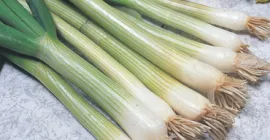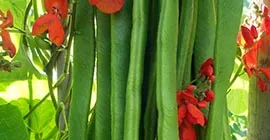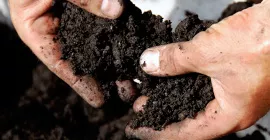Growing your own vegetables from seed is extremely rewarding. It is a much more cost effective way of feeding your family. But, not only this, there is nothing more rewarding than a fantastic crop of tasty veg that you have grown yourself. It gives you the opportunity to experiment with different varieties to grow. Therefore, you will find something that really suits your taste buds.
The method of how to grow veg from seed:
The size of the seeds you are sowing determines the exact method you should use to sow the seeds. However, the principal is the same. The compost is a very important part of growing successful veg from seed. We advise using Gro-Sure Seed and Cutting Compost, because this is specifically developed to ensure perfect growing conditions for seed germination. It contains Vermiculite, to add drainage and aeration, as well as enriched with seaweed to stimulate strong seed germination. It is a fine compost which is great for sowing seeds because it maximises contact. Here is how you sow the seeds!
We’ve put together a shopping list of what you’ll need to start growing your own vegetables and fruit from seed. March/April is when people start sowing their seeds. Don’t panic, you don’t need a greenhouse to grow your own, start them off on your windowsill. Ensure you get some direct sunlight on your chosen windowsill.
Watch our easy to follow video on how to grow veg from seed
Growing your own shopping list:
- Your choice of veg seeds
- Hand Trowel
- Our Gro-Sure Visiroot Trays. They are easy to check roots, to see when your seedlings need watering and can be used year after year. Not only that, they are fully recyclable in your household recycling bin. Don’t forget to get the lids too, as your seedlings will need to be covered for a while.
- New Horizon Peat-Free All Veg Compost. 100% natural and gives your vegetables 3 times more goodness.
- Westland Boost All Purpose Liquid Plant Feed. The only plant feed you’ll ever need! Suitable for: all peat and peat free composts, all ornamental and ericaceous plants and all fruit and vegetables. You might want a bigger garden when you see how much crop you get from feeding your veg this transformational feed.
Enjoy growing your own fruit and vegetables from seed at home. Tomatoes are one of the easiest fruits to grow.
Sowing veg from seed
Small seeds:
- When sowing small seeds it is best to sow in a seed tray. Fill the seed tray with compost and gently press down to flatten the compost. Water the compost so that when you plant the seeds the water doesn’t wash the seeds the way.
- Take the seed pack and open the packet into the palm of your hand. Lightly sprinkle the seeds over the compost surface, spacing it as evenly as possible. If the seeds are clumped together, then they will out compete each other and not grow properly.
- Cover the seeds with a thin layer of vermiculite to help insulate them.
- Label the plants and cover with a propagator lid or cling film to keep them warm.
- Once the plants have germinated and filled the seed tray, you can plant the individual seedlings into their own small pot. Simply loosen the soil, and carefully remove the seedling, and put it into a pot adding more soil if needed. Make sure you are careful not to damage the roots.
Large seeds:
- Larger seeds such as French beans do not need sowing into a seed tray because for ease of planting out you sow each seed in a separate small pot. Fill several small pots with compost.
- Take a dibber or a pencil to make a small hole in each pot. Place one seed into each of these holes and then cover over with compost.
- Give the pots a light water and cover with a propagator lid or cling film until the seeds germinate.
Sowing direct:
A large amount of vegetables can be sown directly in the garden such as broccoli, cabbage and carrots. Seeds can be sown into prepared beds in spring, summer and autumn.
- Prepare the soil on where you are going to sow the seeds to a fine consistency. This is because if the soil is in large clods and heavy then it is going to be hard for the shoot to push through. The bed should also be covered over with a layer of fleece a couple of weeks in advance to sowing to warm up the soil. Try and add some organic materials, such as Gro-Sure Farmyard Manure to introduce more nutrients into the soil.
- Create a drill (small depression in the soil) for the seeds to be sown into. The depth that the seeds should be sown at depends on the type of vegetable so it is best to read the seed pack. However, it is normally three times as deep as the diameter of the seed. Water the drill before sowing the seeds.
- Sow the seeds thinly with good spaces between each seed. If they are too close then they will be competing for nutrients, light and soil against each other. For large seeds aim for spaces of about 4cm (1 to 2 inches) between each seed. For smaller seeds it is harder to get this accurate spacing, but sow evenly and thinly across the whole area.
- Gently cover the seeds with soil and place a label in the soil. Use a fleece to cover the area where the seeds are sown.
Thinning out
Thinning out is the process of removing seedlings from the vegetable patch or seed tray when they are young. This is an important thing to do because it helps to prevent overcrowding as they grow bigger. Once the seeds have germinated and are about 2cm (1 inch) tall, thin them out so that you leave one good plant every 10cm (4 inches). The more room that you give the plants, the stronger they will grow, meaning you produce better vegetables.
Planting out
When the danger of frost has passed, vegetable plants can be planted out directly into the garden soil. Here are the steps to planting out:
- To start with the plants need ‘hardening off’. This is acclimatising them to the outdoors before planting them out. To do this, place your plants outside during the day and then back into the shelter at night.
- Prepare the planting area by digging over with a garden fork, while also removing weeds. This should create a fine tilth.
- Work out the correct spacing and position for your vegetable plants. Dig a hole for each plant.
- Take each plant out of its pot and position in the prepared hole. Fill in around the roots with your compost and firm in gently. Water each plant throughout the growing season.
Plants that grow tall such as peas and beans will need staking to support their growth. Bamboo canes are a good support to.
Feeding
To maximise the crop of vegetable produced, it’s advisable to feed the plants. Sulphate of Ammonia is a great food for vegetable plants. This is because it has a very high nitrogen content. This improves leaf colour, encourages strong steam development and promotes lush, green vegetables.
Following this guide will mean that you produce a juicy and divine crop of vegetables which you can proudly state you have grown from seed!




